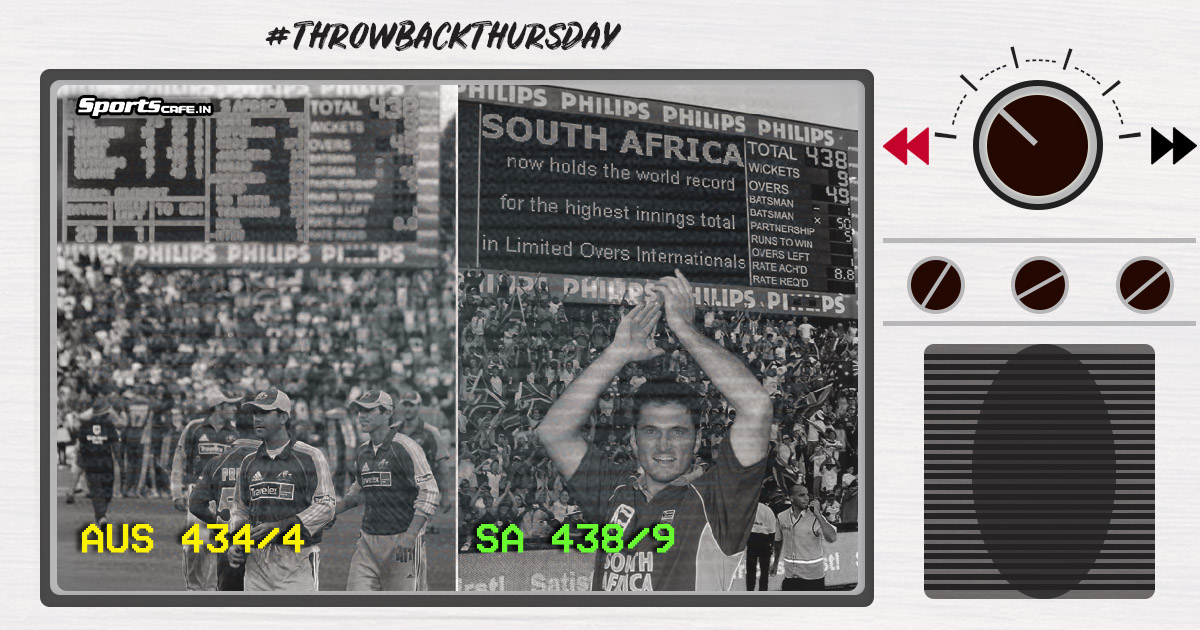Throwback Thursday | South Africa scale Wanderers and Australia’s ODI world record 434
What if you could rewind in time, would you deny the chance or go through it all over again to live a moment in history. Welcome to the series where we present you a moment, a game in history that has shaped the way ODI cricket has been played, in our weekly segment ‘Throwback Thursday.'

It is March 12 2006, just south of Sandton in Illovo, Johannesburg in South Africa at the Wanderers, wicketkeeper-batsman Mark Boucher is at the crease, facing one of the best bowlers in the world, Brett Lee with one run to win off two balls. He just needs to get one shot over the fielder for South Africa to win the game.
For that, we need to understand what happened in his contest, the prior contest and the rivalry between the two countries.
Their cricketing history dates to the early 90s, when South Africa’s brand of cricket was condescending to the ones played by the Australian team. February 26 1992, Australia met South Africa in the then Benson & Hedges World Cup at Sydney, where Allan Donald made his World Cup debut. Australia were fresh off from their first World Cup victory and faced the tournament debutants, at their own home. After electing to bat, they crashed to 170 giving South Africa their easiest of victories in their debut tournament.
The game demanded a replay as Australia were looking for blood and South Africa, to post the D in dominance. They had to wait for the turn, with the Australian team put in Group of the 1996 World Cup while South Africa found themselves in the other group. It was 1999 and for the first time, both the sides entered the semi-final, where they met each other. On June 17 1999, Australia locked horns with the Proteas side in Birmingham. This time, South Africa put Australia to bat, on the back of their previous World Cup visit, where they failed to defend 271. Waugh’s side faltered in the semi-finals, batting first, at 68-4 before they reached 213.
And, South Africa too struggled early on and in the middle overs. However, a late resurgence meant they needed nine off six deliveries to win. Lance Klusener scored two fours, with Australia needing two wickets to reach the finals. One run needing off the last two, Klusener stroked one to mid-off and charged while Allan Donald was caught ball watching. It was 2-1, with Australia leading. They did not meet in the 2003 World Cup, in which Australia went on to win.
How did we get here?
Fresh off their World Cup and ahead of the next one, they toured South Africa in 2006 in the Standard Chartered Bank ODI series. South Africa steamrolled Australia in the first ODI, with Shaun Pollock and Graeme Smith putting up a dominant display to lead the five-match series 1-0. And, they continued to dominate in the second one, where Australia were batting like a pack of headless chickens, going to slumber with the bat. Makhaya Ntini proved to be a handful, picking up six wickets. 2-0 up at home, one game to go, Australia were struggling without skipper Ricky Ponting.
Ponting returned in the third game and starred immediately scoring 62 while Brett Lee picked up four wickets of his own. The Proteas were still leading the series 2-1 and needed one win. For Australia, they need one more to keep the series alive and kicking than see the dead meat. In the fourth ODI, South Africa scored 249 in their 50 overs. Australia needed to get off the box immediately, with Adam Gilchrist and Simon Katich putting up a quickfire partnership.
Andrew Symonds turned to be the saviour for Australia on the night, with a late cameo from Stuart Clark taking Australia into the fifth match at the iconic Wanderers. The series locked up at 2-2, one game that could swing in either of the side’s way at the stadium where Australia have won four out of the six games. Australia’s batting order was in bits and pieces, South Africa’s bowling order knitted tightly like a grandmother’s sweater. That brings us to the game the world would remember fondly for generations to come.
On the day
Earlier in the day, Shaun Pollock was ruled out, putting the hosts in a tough spot. This was the same venue where Australia had scored 350 against India in the 2003 Cricket World Cup Final, where Ponting put on a masterclass. The visitors won the toss and elected to bat, with the pitch looking solid for batsmen, with a 300+ score expected. The Australian openers - Gilchrist and Simon Katich put on a great start, racing off to 66 runs after ten overs, with a strike rate nearing 100 for the duo in the era of 75 strike rate. It took a stinger from Andrew Hall to dismiss Gilchrist for a 44 ball 55 runs. And then stepped in Australia’s skipper and arguably the best ODI batsman in 2006, Ricky Ponting.
Straight away, he looked at home in South Africa, where he has had happy memories of hunting opposition with his pull shot and the hoick over the leg-side. For South Africa, it spelt t-r-o-u-b-l-e. Smith added to the fire trying to sledge his Australian counterpart and the game was breathing fire. As soon as Roger Telemachus walked in, Ponting was ready to attack, standing there like a lion waiting for its prey. And, he flicked one to the boundary to warm up. Australia were getting started and looked to put a score beyond the African boundary. In Pollock’s absence, South Africa lacked leadership and failed immediately, bowling wayward to the Australian batsmen.
With 300 being the predicted score, the visitors looked to smash all records, with Ponting joined by an in-form Michael Hussey. The southpaw had already played a couple of match-winning innings to take Australia to the fifth, and this game was his to complete the circle. Every bowler was not met with a hello but rather a boundary and ones beyond the boundary. It looked like there was no bowler who could meet Ponting eye-to-eye on the night. Meanwhile, Hussey at the other end slowly started putting up a party of his own, having scored a fifty off just 31 deliveries. And, in the next 21, he went on to score 31, including monstrous sixes on the leg-side made look easy. Ponting went on to score a century and piled up on it, scoring 164 off 105 deliveries. By then, Australia had already reached the highest total in ODI history - 400.
But they were not done, they wanted more, with Andrew Symonds putting on the final touch, with an expensive over from Telemachus. Australia got to 434, and seemingly put the game to bed. At 3/1, the home side were on the back foot. Herschelle Gibbs stepped in and knew that he needed to pull off a Ponting-esque innings if the home side needed to post a victory. For Australia, they had to defend the highest total in ODI history. Slowly yet steadily, Smith and Gibbs put on a show, taking the inexperienced Australian bowling unit for a ride around the Wanderers. The bowlers saw what they had never seen before and Mick Lewis was put to bed forever after the game. South Africa had already scored 71 in nine overs and were not done.
Australia, owing to pressure, missed a strategy letting South Africa off the hook, with Gilchrist still opting to stand deep to the pacers when the home side were walking the track to score boundaries. The crowd cheer intensified every delivery, the noise cancelled out the minuscule voice notes of the Australians at the stadium. Michael Clarke dismissed Smith, as Australia saw a light. However, Gibbs at the other end was adamant that he was taking the home side to a victory. And then, Nathan Bracken dropped Gibbs when he was at 130, another opportunity went past the visitors at 245-2. Alongside the new man AB de Villiers, the home side were getting a proper go at Australia. Bracken dismissed de Villiers and Symonds followed it with Gibbs’ dismissal. 299/4, the game swung Australia’s way like a pendulum. Symonds added to his wicket tally with Jacques Kallis’ dismissal. 358/6 and the game was slipping out of the home side’s favour.
Johan van der Vath’s partnership with Mark Boucher turned the game once again in Proteas favour. Bracken was once again amongst the wickets dismissing van der Vath for 35. 30 off three overs, Telemachus and Boucher were still there, with the target looking daunting than ever. Bracken bowled the 49th and immediately picked up the wicket of Telemachus. Two wickets separated Australia from a victory and South Africa from a what-if. Hall scored a boundary and was dismissed and Makhaya Ntini got off the strike, with South Africa needing a run to win. Okay here in the 50th over, Boucher at strike, Brett Lee bowling.
Welcome to a moment in history
— faceplatter49 (@faceplatter49) February 20, 2020

Comments
Sign up or log in to your account to leave comments and reactions
0 Comments